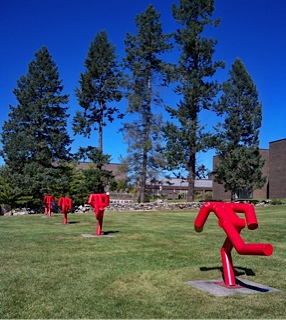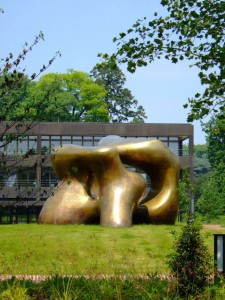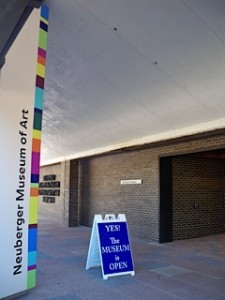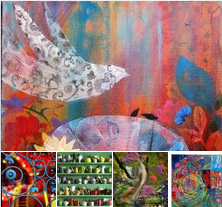I come home with a coloring book, the cover artwork by Rob Pruitt. It depicts two zebras, with a few of their white stripes colored purple, blue, and a rusty red. The title of the book is Between the Lines. I’m a sucker for coloring books. I love the outline of inspiration inviting me to fill in the blanks. I also cannot resist stopping at the gift shop when exiting the Neuberger Museum of Art. But I am beginning at the end, so let me start now at the beginning.


One can google Purchase College and discover its notorious place on the many lists of “ugliest universities.” But I think the Purchase campus—its architecture and layout, the proximity between all the buildings, and the expanse of nature surrounding it—is brilliant. It is a vast landscape of gently rolling meadows and forest, in the center of which are the academic and administrative buildings, gymnasium, residence halls and apartments, and the museum. The school, founded in 1967, was designed by Edward Larrabee Barnes; the first building finished was the Neuberger Museum of Art. A few of the older historic buildings (legacy of the Thomas family), as well as a family cemetery, remain, and are located in a solitary area a short walking distance behind the museum. The contrast between the university’s austere, block-like brick buildings and the exuberant miscellany of nature makes sense. In the halls of these ordered and sensible buildings one can concentrate on the knowledge being taught and shared, then step outside and be inspired by a sense of wonder and awe to take what has been learned and make it new.
Rounding the curve in the road I can see the monolithic Performing Arts Center. I pull into the W1 parking lot, excited to be back on campus. I walk up to the Visual Arts building, which is in between the parking lot and the museum. There, installations by art students stand alongside the outdoor sculptures of established professional artists. I cut through the building. The work of so many artists-in-the-making is on display; so much creative energy in the air. The Richard & Dolly Maass Gallery, a light-filled space where exhibits coordinate with students’ classroom experiences, is at the end of the main hallway. The current exhibit is Stand Up and Be Counted, works by Antonio Frasconi (1919-2013), artist and professor emeritus of Purchase College.
Stepping outside I am greeted by tall swaying grasses under a clear blue sky. The mall is filled with benches, more sculpture, trees, plants, and students walking or sitting or biking.

In senior year, as a museum intern, I developed a guided tour based on four works in the permanent collection that focused on male artists’ depictions of women. I climb the stairs to the Permanent Collection of Modern and Contemporary Art to see if those paintings are on display. I find only one, Max Weber’s La Parisienne (1907). I’m still in love with the curves of the reclining nude, the luscious reds. Nearby I spy Georgia O’Keeffe’s Lake George by Early Moonrise (1930). I stand before it enjoying the the multitude of greens she has painted and am reminded of our yearly family vacations at Lake George. Number 8, 1949 (1949) by Jackson Pollack is there. Giftwares (1955) by Grace Hartigan. Girl on a Terrace (1956) by Richard Diebenkorn.
All are favorites of mine, each stirring memories and emotions from the past. I come to Fruit Bowl Version 6 (1950) by Hans Hofmann and laugh out loud. A friend had come to have lunch with me back when I was working at the Neuberger and we took some time in the galleries. I was looking at another painting when I turned to see her picking at the Hofmann.
“What are you doing?” I said.
“Trying to fix this, ” she answered. “Is this glob of paint supposed to be here?”
Back downstairs I stop in the African Art gallery. The Neuberger’s collection is strongest in the arts of central Africa. Videos complement the works themselves, showing headdresses, masks, costumes, and musical instruments being used in actual ceremonies in their originating lands.
I make my way to the last gallery to view Key Frames: Contemporary Artists’ Animation. The playlist for this exhibition of recent animated shorts rotates, so there is always something new to see. The exhibit remains until January 11. Three screens show different films, but I am immediately drawn to one. A girl and a boy, similar to the images in the Dick and Jane readers, chase animals and perform grotesque acts of greed and violence against a backdrop of idyllic pastures and glorious sunsets and sunrises. Objects, animals, insects, and actions are labeled in large type, as if this were all just a vocabulary lesson. The film, Rabbit by Run Wrake (1965-2012), is beautiful and eerie. I watch it several times. For me it captures the discordant mixture of wonder and fear that comprised much of my childhood. I feel enchanted and disturbed as the story unfolds over and over again.
Then it’s back to the bright open space of the lobby and gift shop. After browsing the fun, eclectic collection of goods I pick up the coloring book. Its combination of childlike play and incongruous imagery spurs my imagination. Rabbit, perhaps, has also inspired my choice.
Cover photo by Neal Fowler, Creative Commons license via Flickr. Two Large Forms image via Wikipedia, public domain. Museum and campus photos by the author. Post by Victoria Addesso, coauthor of Still Here Thinking of You: A Second Chance With Our Mothers.
Browse more Literary Tours
______________________
At Tweetspeak Poetry, we are committed to helping people become who they really are. We believe in the power of community reading, writing, playing, and just plain living, to accomplish this.
Live richly, deeply. Become a master in “fine living.”
- Regional Tour: Neuberger Museum of Art, Purchase College, NY - October 22, 2014
- Journey into Poetry: Victoria Addesso - May 30, 2014

L. L. Barkat says
This is such a great description of the campus, Vicki. I have this odd feeling in both directions when I am there. The spareness of the buildings set in the beauty of the space.
Oh my goodness, on the painting-fixing!
(Loved the way you put together thoughts on art in this, too.)
Vicki Addesso says
Thank you, Laura! And I still get shivers when I think back to my friend trying to pick paint off the painting to “fix it”!!!
Maureen Doallas says
I am always impressed with college and university art holdings; some of them are among the very best. I’ve not been on the Neuberger campus but these works make me want to go.
Your opening gave me another idea for The Mischief Cafe: a set of ekphrastic poetry coloring books based on our literary art tours here at TSP.
Vicki Addesso says
Yay!!! Great idea!
Donna says
Wow I would really love to visit this gallery.
I just about had a heart attack at your friend picking at the glob of paint LOL!
Thank you for a wonderful tour!!
Vicki Addesso says
You are so very welcome, Donna! Hope you do get to visit the Neuberger/Purchase College – so full of wonder & fun…